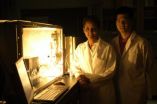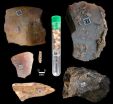(Press-News.org) PASADENA, Calif.—Using a common metal most famously found in self-cleaning ovens, Sossina Haile hopes to change our energy future. The metal is cerium oxide—or ceria—and it is the centerpiece of a promising new technology developed by Haile and her colleagues that concentrates solar energy and uses it to efficiently convert carbon dioxide and water into fuels.
Solar energy has long been touted as the solution to our energy woes, but while it is plentiful and free, it can't be bottled up and transported from sunny locations to the drearier—but more energy-hungry—parts of the world. The process developed by Haile—a professor of materials science and chemical engineering at the California Institute of Technology (Caltech)—and her colleagues could make that possible.
The researchers designed and built a two-foot-tall prototype reactor that has a quartz window and a cavity that absorbs concentrated sunlight. The concentrator works "like the magnifying glass you used as a kid" to focus the sun's rays, says Haile.
At the heart of the reactor is a cylindrical lining of ceria. Ceria—a metal oxide that is commonly embedded in the walls of self-cleaning ovens, where it catalyzes reactions that decompose food and other stuck-on gunk—propels the solar-driven reactions. The reactor takes advantage of ceria's ability to "exhale" oxygen from its crystalline framework at very high temperatures and then "inhale" oxygen back in at lower temperatures.
"What is special about the material is that it doesn't release all of the oxygen. That helps to leave the framework of the material intact as oxygen leaves," Haile explains. "When we cool it back down, the material's thermodynamically preferred state is to pull oxygen back into the structure."
Specifically, the inhaled oxygen is stripped off of carbon dioxide (CO2) and/or water (H2O) gas molecules that are pumped into the reactor, producing carbon monoxide (CO) and/or hydrogen gas (H2). H2 can be used to fuel hydrogen fuel cells; CO, combined with H2, can be used to create synthetic gas, or "syngas," which is the precursor to liquid hydrocarbon fuels. Adding other catalysts to the gas mixture, meanwhile, produces methane. And once the ceria is oxygenated to full capacity, it can be heated back up again, and the cycle can begin anew.
For all of this to work, the temperatures in the reactor have to be very high—nearly 3,000 degrees Fahrenheit. At Caltech, Haile and her students achieved such temperatures using electrical furnaces. But for a real-world test, she says, "we needed to use photons, so we went to Switzerland." At the Paul Scherrer Institute's High-Flux Solar Simulator, the researchers and their collaborators—led by Aldo Steinfeld of the institute's Solar Technology Laboratory—installed the reactor on a large solar simulator capable of delivering the heat of 1,500 suns.
In experiments conducted last spring, Haile and her colleagues achieved the best rates for CO2 dissociation ever achieved, "by orders of magnitude," she says. The efficiency of the reactor was uncommonly high for CO2 splitting, in part, she says, "because we're using the whole solar spectrum, and not just particular wavelengths." And unlike in electrolysis, the rate is not limited by the low solubility of CO2 in water. Furthermore, Haile says, the high operating temperatures of the reactor mean that fast catalysis is possible, without the need for expensive and rare metal catalysts (cerium, in fact, is the most common of the rare earth metals—about as abundant as copper).
In the short term, Haile and her colleagues plan to tinker with the ceria formulation so that the reaction temperature can be lowered, and to re-engineer the reactor, to improve its efficiency. Currently, the system harnesses less than 1% of the solar energy it receives, with most of the energy lost as heat through the reactor's walls or by re-radiation through the quartz window. "When we designed the reactor, we didn't do much to control these losses," says Haile. Thermodynamic modeling by lead author and former Caltech graduate student William Chueh suggests that efficiencies of 15% or higher are possible.
Ultimately, Haile says, the process could be adopted in large-scale energy plants, allowing solar-derived power to be reliably available during the day and night. The CO2 emitted by vehicles could be collected and converted to fuel, "but that is difficult," she says. A more realistic scenario might be to take the CO2 emissions from coal-powered electric plants and convert them to transportation fuels. "You'd effectively be using the carbon twice," Haile explains. Alternatively, she says, the reactor could be used in a "zero CO2 emissions" cycle: H2O and CO2 would be converted to methane, would fuel electricity-producing power plants that generate more CO2 and H2O, to keep the process going.
INFORMATION:
A paper about the work, "High-Flux Solar-Driven Thermochemical Dissociation of CO2 and H2O Using Nonstoichiometric Ceria," was published in the December 23 issue of Science. The work was funded by the National Science Foundation, the State of Minnesota Initiative for Renewable Energy and the Environment, and the Swiss National Science Foundation.
Written by Kathy Svitil
Contact: Deborah Williams-Hedges
debwms@caltech.edu
(626) 395-3227
Visit the Caltech Media Relations website at http://media.caltech.edu.
New reactor paves the way for efficiently producing fuel from sunlight
2011-01-20
ELSE PRESS RELEASES FROM THIS DATE:
Malaria parasite caught red-handed invading blood cells
2011-01-20
Australian scientists using new image and cell technologies have for the first time caught malaria parasites in the act of invading red blood cells. The researchers, from the Walter and Eliza Hall Institute in Melbourne, Australia, and the University of Technology, Sydney (UTS), achieved this long-held aim using a combination of electron, light and super resolution microscopy, a technology platform new to Australia.
The detailed look at what occurs as the parasite burrows through the walls of red blood cells provides new insights into the molecular and cellular events ...
Fears of Ontario pharmacy shortage after slashed generic drug prices unfounded: UBC research
2011-01-20
A University of British Columbia study shows that there are enough pharmacies situated throughout Ontario communities to absorb many closures without negatively affecting geographical accessibility for residents. The research suggests concerns that reducing generic pricing could result in pharmacy shortages are unfounded.
Last summer, the Ontario government cut the price of generic drugs by half – to approximately 25 per cent of the equivalent brand – leading to heated discussions on the sustainability of existing pharmacies. Some pharmacy chains claimed they might be ...
Man, volcanoes and the sun have influenced Europe's climate over recent centuries
2011-01-20
An International research team has discovered that seasonal temperatures in Europe, above all in winter, have been affected over the past 500 years by natural factors such as volcanic eruptions and solar activity, and by human activities such as the emission of greenhouse gases. The study, with Spanish involvement, could help us to better understand the dynamics of climate change.
Up until now, it was thought that Europe's climate prior to 1900 was barely affected by external factors, but now a group of scientists has shown that natural phenomena such as volcanic eruptions ...
Unfolding pathogenesis in Parkinson's
2011-01-20
The study, published in the Journal of Clinical Investigation, reveals that damaged alpha-synuclein proteins (which are implicated in Parkinson's disease) can spread in a 'prion-like' manner, an infection model previously described for diseases such as BSE (mad cow disease).
"This is a significant step forward in our understanding of the potential role of cell-to-cell transfer of alpha-synuclein in Parkinson's disease pathogenesis and we are very excited about the findings", says Professor Patrik Brundin at Lund University, Sweden, who led a team of investigators from ...
Neiker-Tecnalia makes progress in detection and prevention of infection by visna maedi virus
2011-01-20
Researchers at Neiker-Tecnalia (the Basque Institute for Agricultural Research and Development) have undertaken a study on the epidemiology and diagnosis of infection by visna/maedi virus. This is a virus that affects sheep herds causing chronic interstitial pneumonia, mastitis and neurological disorders. The study confirmed that horizontal transmission (direct contact between infected animals) of the virus is the most likely path of infection, rather than vertical transmission (from infected suckling milk or colostrum). Since there is no current effective treatment against ...
Data matrix codes used to catalogue archaeological heritage
2011-01-20
The research team at the Centre for the Studies of Archaeological and Prehistoric Heritage (CEPAP) of Universitat Autònoma de Barcelona (UAB) have implemented an innovative system to register archaeological artefacts which eliminates problems in manual markings, such as errors in writing or erosion of data. The system, based on direct labelling using bi-dimensional data matrix (DM) codes, has been used by the CEPAP team during two years, in which numerous artefacts and bone remains from sites in Spain and Africa were registered.
The marking of archaeological material, ...
Challenging the limits of learning
2011-01-20
Tel Aviv -- Although we're convinced that baby is brilliant when she mutters her first words, cognitive scientists have been conducting a decades-long debate about whether or not human beings actually "learn" language.
Most theoretical linguists, including the noted researcher Noam Chomsky, argue that people have little more than a "language organ" -- an inherent capacity for language that's activated during early childhood. On the other hand, researchers like Dr. Roni Katzir of Tel Aviv University's Department of Linguistics insist that what humans can actually learn ...
Better learning through handwriting
2011-01-20
Associate professor Anne Mangen at the University of Stavanger's Reading Centre asks if something is lost in switching from book to computer screen, and from pen to keyboard.
The process of reading and writing involves a number of senses, she explains. When writing by hand, our brain receives feedback from our motor actions, together with the sensation of touching a pencil and paper. These kinds of feedback is significantly different from those we receive when touching and typing on a keyboard.
Learning by doing
Together with neurophysiologist Jean-Luc Velay at the ...
Malignant brain tumors: Benefit of PET and PET/CT in the detection of recurrences is not assessable
2011-01-20
Malignant gliomas are fast-growing brain tumours with poor prospects of recovery depending on disease stage. Experts hope that the examination of patients by means of positron emission tomography (PET) is more helpful in the choice of the right treatment than other procedures. In a final report the German Institute for Quality and Efficiency in Health Care (IQWiG) has now investigated the benefit of PET in the detection of recurrences. According to this report, no robust conclusions are possible on the advantages or disadvantages of PET.
Two research questions investigated
The ...
Migraines and headaches present no risk to cognitive function
2011-01-20
Recent work, in particular the CAMERA study, has used MRI to study the brains of migraine sufferers and has shown that a higher proportion of these patients exhibit lesions of the brain microvessels than the rest of the population.
Lesions of the brain microvessels
Lesions of the brain microvessels, visible on cerebral MRI images, can be of various kinds: white-matter hyperintensities and, more rarely, silent infarcts leading to loss of white-matter tissue.
They result from a deterioration of the small cerebral arteries that supply blood to the brain's white matter, ...



